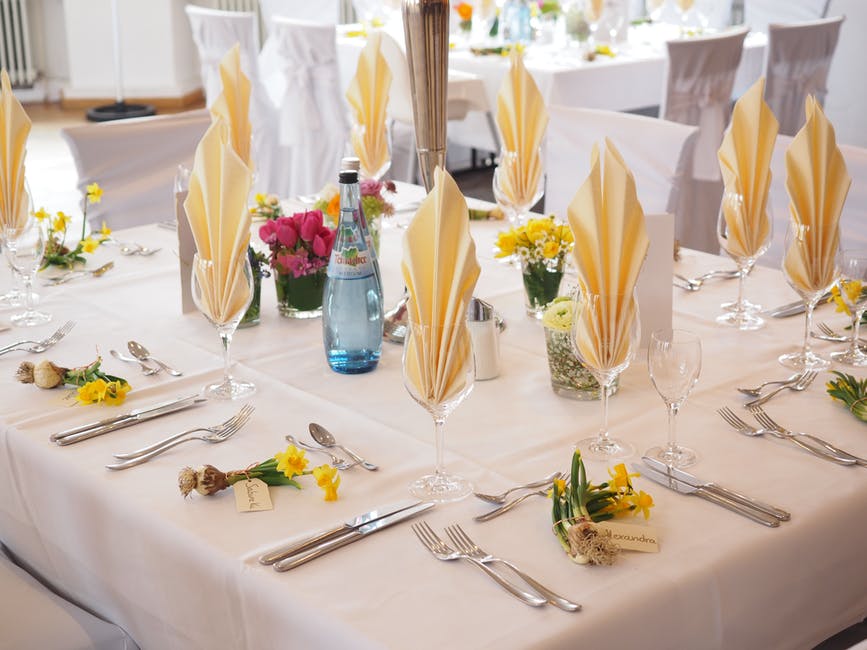A lot of people don’t think of tablecloths unless they need one. Most likely, they will be getting some when they will be hosting events, parties and special family dinners. This is because tablecloths are used to dress up their table to fit a certain motif or set the mood for an occasion, besides serving as a protection for the table.
The choice of tablecloth material depends on the budget, purpose, quality, theme, design, the desired color and desired appearance. Here are some of the different tablecloth fabrics out there to choose from:
1. Linen
Don’t confuse this one as table linens in general. Tablecloth linens are made from a flax plant, and it has been traditionally used for hundreds of years. It was first used by families in the medieval period and has been a sign of elegance and luxury today. Linen is fairly smooth, soft and cool to the touch, adding a classy touch to the table. It is more durable than cotton since it has longer fibers. It is also durable and fairly resistant to stains. Linen is somewhat expensive, but it can last for generations if taken care of very well. Plus, it suits a lot of special events, especially formal gatherings.
2. Cotton
Cotton, as a tablecloth option, is very popular and cheap, since this material is easily manufactured. It is versatile and can suit both casual and formal occasions, but it is used mostly for informal events. Cotton can withstand a lot of wear and tear and can be washed just like how you wash your cotton clothing item. However, cotton can shrink through rewashing. It comes in many different colors, designs, and patterns, and its quality may vary dramatically. Cotton tablecloths work best in dining rooms, kitchen area, and outdoor eating settings.
3. Polyester
Polyester is a synthetic fiber that can be weaved to imitate linen and other delicate forms of fabric at a more affordable price. It is a bit similar to cotton, but is more shiny and silky, making it great for formal gatherings. Pure polyester tablecloths are a spill, shrink, wrinkle and stain-resistant, and are mostly lint-free. It doesn’t absorb liquid very well but it is the easiest material to take care of. Polyester retains its size and shapes even with repeated washings. It is also highly durable and less prone to fading.
4. Poly-cotton and polyspun
Polyester is usually blended with cotton to make an inexpensive, durable and high-quality tablecloth material. A blend of 50% polyester and 50% cotton makes a poly-cotton fabric, which lasts twice as long as pure cotton. It has the softness of cotton and also the wrinkle-resistance of polyester. Meanwhile, a polyspun tablecloth has more polyester component (65%) than cotton (35%). It lasts longer than poly-cotton, and resists wrinkling, shrinking, staining and piling like pure polyester.
5. Silk
The most expensive tablecloth material, guests will surely be impressed with silk. Silk tablecloths come in many different designs and some come with special embroidery. It is very soft and delicate and provides a luxurious look that works best for formal events. However, its softness and delicacy is also its downside – you have to be careful in maintaining and washing silk tablecloths. It is suitable only for indoor dining.
6. Vinyl
For outdoor eating and casual dining, vinyl works as an affordable choice. It is a synthetic material that is used to make a wide range of items, including tablecloths. Its texture falls in between thin plastic and polyester, making it perfect for the outdoors. Vinyl provides a quick, decorative change you can use that can be easily cleaned when stained. There is no laundering needed for vinyl tablecloths – you just need to wipe them clean. It is fairly durable than disposable tablecloths, and it can be used again and again. It also has great resistance to weather, humidity, and sunlight.
7. Plastic
Plastic table covers protect your tables better than its fabric counterparts because of its water and stain-resistant properties. It is used mostly for events where covering the table is more important than how it would look, as plastic table covers look cheaper than most tablecloths. It is sold in many different colors, prints, and patterns. There are also transparent variants that are sometimes layered over much more delicate tablecloths. Typically, plastic table covers are to be used once only and is intended to make after-party cleanup easier. However, if it’s not torn yet, then you may reuse it again. You just have to keep containers containing hot food placed on top of it (unless there are thick coasters) because the plastic might melt.
8. Satin
If you like a bit of silky shine to your tablecloth, satin is the less expensive alternative. Satin is formed by making satin weaves using filament fibers. It is known to have one shiny side and one matte side, making it reversible. Its glossiness has a very even sheen. Satin tablecloths are perfect for formal events.

